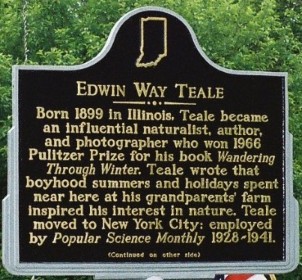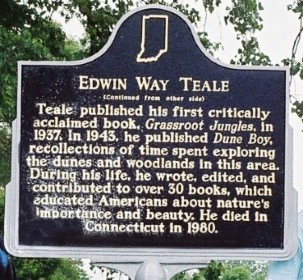

Location: 285 E. U.S. Highway 20, Chesterton, IN (Porter County)
Installed: 2009 Indiana Historical Bureau and Musette Lewry Trust
ID#: 64.2009.1
Narrative research summary available here.
![]() Visit the Indiana History Blog to learn more about Teale's life and work.
Visit the Indiana History Blog to learn more about Teale's life and work.
Text
Side One
Born 1899 in Illinois, Teale became an influential naturalist, author, and photographer[ who won 1966 Pulitzer Prize for his book Wandering Through Winter. Teale wrote that boyhood summers and holidays spent near here at his grandparents’ farm inspired his interest in nature. Teale moved to New York City; employed by Popular Science Monthly 1928-1941.
Side Two
Teale published his first critically acclaimed book, Grassroot Jungles, in 1937. In 1943, he published Dune Boy, recollections of time spent exploring the dunes and woodlands in this area. During his life, he wrote, edited, and contributed to over 30 books, which educated Americans about nature’s importance and beauty. He died in Connecticut in 1980.
Keywords
Education & Libraries, Nature & Natural Disasters, Newspapers & Media
Annotated Text
Edwin Way Teale [1]
Side One
Born 1899 in Illinois,[2] Teale became an influential naturalist, author, and photographer[3] who won 1966 Pulitzer Prize for his book Wandering Through Winter.[4] Teale wrote that boyhood summers and holidays spent near here at his grandparents’ farm inspired his interest in nature.[5] Teale moved to New York City; [6] employed by Popular Science Monthly 1928-1941.[7]
Side Two
Teale published his first critically acclaimed book, Grassroot Jungles, in 1937.[8] In 1943, he published Dune Boy, recollections of time spent exploring the dunes and woodlands in this area.[9] During his life, he wrote, edited, and contributed to over 30 books, which educated Americans about nature’s importance and beauty.[10] He died in Connecticut in 1980.[11]
Notes
Born Edwin Alfred Teale, Edward Dodd, who published most of Teale’s books, states, “[Teale] was christened Edwin Alfred Teale [but] felt this was too commonplace for a future Thoreau,” and changed his name. Dodd mentions that Thoreau also changed his name. Edward H. Dodd, Of Nature, Time and Teale: A Biographical Sketch of Edwin Way Teale (New York, 1960), 9 (B070682).
The Biographical Dictionary of American and Canadian Naturalists and Environmentalists claims that Teale changed his middle name to Way when he was twelve years old. George Cevasco, “Edwin Way Teale,” Biographical Dictionary of American and Canadian Naturalists and Environmentalists (Westport, CT, 1997), 769 (B071006).
- “Edwin Way Teale,” World War I Draft Registration Card, Registration Location: Will County, Illinois; Roll: 1642841; Draft Board: 2. http://search.ancestrylibrary.com/ (accessed January 9, 2008) (B070693); “Edwin Teale,” Social Security Death Index, Number: 094-01-8570; Issue State: New York; Issue Date: Before 1951. http://search.ancestrylibrary.com/ (accessed January 9, 2008) (B070700).
- An article in the New York Times, published during his lifetime, referred to Teale as “probably the greatest living naturalist in America,” and stated, “his books are used as standard textbooks on nature in many universities.” Leonard Dubkin, “Old Friends in a New Light,” New York Times, October 14, 1962, p. 285 (accessed January 29, 2008 through ProQuest Historical Newspapers) (B070874).
An online exhibition hosted by the University of Connecticut, where Teale’s personal papers, records, manuscripts, photos, and awards are housed, states Teale was “one of the best-loved naturalists of his generation.” Teale was an “accomplished photographer who pioneered new techniques for creating close-up images of insects and other living things.” “Edwin Way Teale,” Online Exhibition, University of Connecticut Libraries http://www.lib.uconn.edu/about/exhibits/carroll/ewteale/teale.html (accessed January 8, 2008) (B070683).
Many articles, reviews, and biographies compare Teale to Henry David Thoreau, John Muir, and John Burroughs. “Edwin Way Teale,” Online Exhibition, University of Connecticut Libraries (B070683); Harold W. Wood, “Book Review: The Wilderness World of John Muir,” Sierra Club, http://www.sierraclub.org/john_muir_exhibit/frameindex.html (accessed January 1, 2008) (B070690); Carl Carmer, “Mountain Love Song,” New York Times, July 4, 1954, p. BR9 (accessed January 18, 2008 through ProQuest Historical Newspapers) (B070820).
Roger Tory Peterson, a prominent naturalist, wrote, “Teale soon found himself in the vanguard of a new aristocracy of naturalists which was to include Rachel Carson and several others.” Roger Tory Peterson, “Time of Rest, Rebirth and Hope,” New York Times, October 24, 1965, p. BR1 (accessed February 1, 2008 through ProQuest Historical Newspapers).
- Edwin Way Teale, Wandering Through Winter (New York, 1965) (B071433); “The Pulitzer Prize Winners 1966 General Non-Fiction,” The Pulitzer Prizes, http://www.pulitzer.org/ (accessed February 8, 2008 by searching the archive for “Edwin Way Teale”) (B070942); “Biographical Sketches of the 1966 Winners of the Pulitzer Prizes,” New York Times, May 3, 1966, p. 43 (accessed February 1, 2008 through ProQuest Historical Newspapers) (B070901).
- Teale wrote that he spent summers, “Christmas, Thanksgiving and Easter vacations” at his grandparents’ farm. Teale stated that it was at this farm where “a new world opened up around me. During my formative years, from earliest childhood to the age of fifteen, I spent my most memorable months here, on the borderland of the dunes.” Edwin Way Teale, Dune Boy: The Early Years of a Naturalist (Bloomington, 1943), 6-7 (B070916).
Teale also described a winter ride at his grandparents’ farm as “a starting point and a symbol. It was a symbol of all the veiled and fascinating secrets of the out-of-doors. It was the starting point of my absorption into the world of Nature.” Edwin Way Teale, The Lost Woods (New York, 1945), 1-5.
- Teale lived in New York City by 1924 because he began school at Columbia University in September of that year. Jocelyn K. Wilk, Public Service Archivist for Butler Library at Columbia University, confirmed that official student records show Teale enrolled at Columbia University from September 1924 to June 1925 and that he received his master’s degree in English literature on October 27, 1926. Jocelyn Wilk, e-mail, based on official registrar records and June 1, 1927 commencement program, received February 8, 2008 (B070986).
The 1930 Census recorded that Teale lived in New York. U.S. Bureau of the Census, Fifteenth Census (1930) Population Schedule, Hempstead, Nassau, New York; Roll: 1460; Page: 6B; Enumeration District: 127; Image: 957.0. http://search.ancestrylibrary.com/ (accessed February 15, 2008) (B070993).
- In 1928, Popular Science hired Teale as a staff writer. Dodd, 10-11 (B070682); Cevasco, 769 (B071006); Catherine E. Forrest Weber, “Always the Other Spring! The Life and Nature Writing of Edwin Way Teale,” Traces of Indiana and Midwestern History, 7 (Spring 1995): 28 (B070762).
On October 15, 1941, Teale left his job at Popular Science to become a freelance writer and photographer. Popular Science 138, no. 4 (1941): 2, 120; Popular Science 139, no. 4 (1941): 97; Popular Science 139, no. 6 (1941): no page number; Popular Science 140, no. 1 (1941): 4; Dodd, 15 (B070682); Weber, 28 (B070762). Weber states that Teale called the day he quite Popular Science his “own personal Independence day.”
- The first review of Grassroot Jungles to appear in the New York Times was mixed. Reviewer Ralph Thompson criticized Teale for being so impressed by the insects that he does not include enough facts. Ralph Thompson, “Books of the Times,” New York Times, October 27, 1937, p. 29 (accessed January 9, 2008 through ProQuest Historical Newspapers) (B070712).
Anita Moffet, “Exploring the Insect World,” New York Times, December 19, 1937, p. 89 (accessed January 9, 2008 through ProQuest Historical Newspapers) (B070714). Moffet’s review is much more positive than Thompson’s from two months earlier. She calls the photographs “extraordinary” and the writing “graphic and imaginative.”
Roger Tory Peterson, “Time of Rest, Rebirth and Hope,” New York Times, October 24, 1965, p. BR1 (accessed February 1, 2008 through ProQuest Historical Newspapers) (B070899). Peterson’s review came more than twenty years after the publication of Grassroot Jungles, and provides some historical perspective of the work. Peterson claimed that good nature writing declined until Teale’s Grassroot Jungles was published in 1937. Peterson placed Teale “in the vanguard of the new aristocracy of naturalists.” He stated that Teale’s careful facts served his ideas.
- Teale, Dune Boy (B070916), “Books--Authors,” New York Times, October 11, 1943, p. 17 (accessed January 9, 2008 through ProQuest Historical Newspapers) (B070751); "Latest Books," New York Times, October 24, 1943, p. BR34 (accessed January 9, 2008 through ProQuest Historical Newspapers) (B070752).
- Books Written by Teale: 1. The Book of Gliders (1930) children’s
2. Grassroot Jungles (1937)
3. Boy’s Book of Insects (1939) children’s
4. Boy’s Book of Photography (1939) children’s
5. The Golden Throng (1941)
6. Near Horizons (1942)
7. Dune Boy (1943)
8. Byways to Adventure (1944)
9. Exploring the Insect World (1944)
10. The Lost Woods (1945)
11. Days Without Time (1948)
12. North with the Spring (1951)
13. Circle of Seasons (1953)
14. Insect Friends (1955)
15. Autumn Across America (1956)
16. Adventures in Nature (1959)
17. Journey into Summer (1960)
18. The Lost Dog (1961) children’s
19. The Strange Lives of Familiar Insects (1962)
20. Audubon’s Wildlife (1964)
21. Wandering through Winter (1965)
22. Springtime in Britain (1970)
23. Photographs of American Nature (1972)
24. A Naturalist Buys an Old Farm (1974)
25. A Walk Through the Year (1978)Editing, Introductory, Commentary, Photo or Chapter Contributions:26. Walden (1946)
27. Insect World of J. Henri Fabre (1949)
28. Green Treasury (1952)
29. The Wilderness World of John Muir (1954)
30. Plant Marvels in Miniature (1961)
31. The Wonderful World of Nature (1962)
32. The Thoughts of Thoreau (1962)
33. African Wildlife (1965)
34. Vermont Life Book of Nature (1967)
35. Songbirds in Your Garden (1968)
36. The American Seasons (1976) – collection of chapters from the entire four volume series
37. A Conscious Stillness (1982) – co-wrote, published posthumously*Other children’s books – possibly reprints/adaptations of other works38. Insect Friends (1955)
39. The Bees (1967) (republished from Golden Throng)
40. Junior Book of Insects (1972) - “Edwin Teale,” Social Security Death Index, Number: 094-01-8570; Issue State: New York; Issue Date: Before 1951. http://search.ancestrylibrary.com/ (accessed January 9, 2008) (B070700).
Joan Cook, “Edwin Way Teale Is Dead at 81; Won Pulitzer for Study of Winter,” New York Times, October 21, 1980, p. B10 (accessed January 9, 2008 through ProQuest Historical Newspapers) (B070799).
